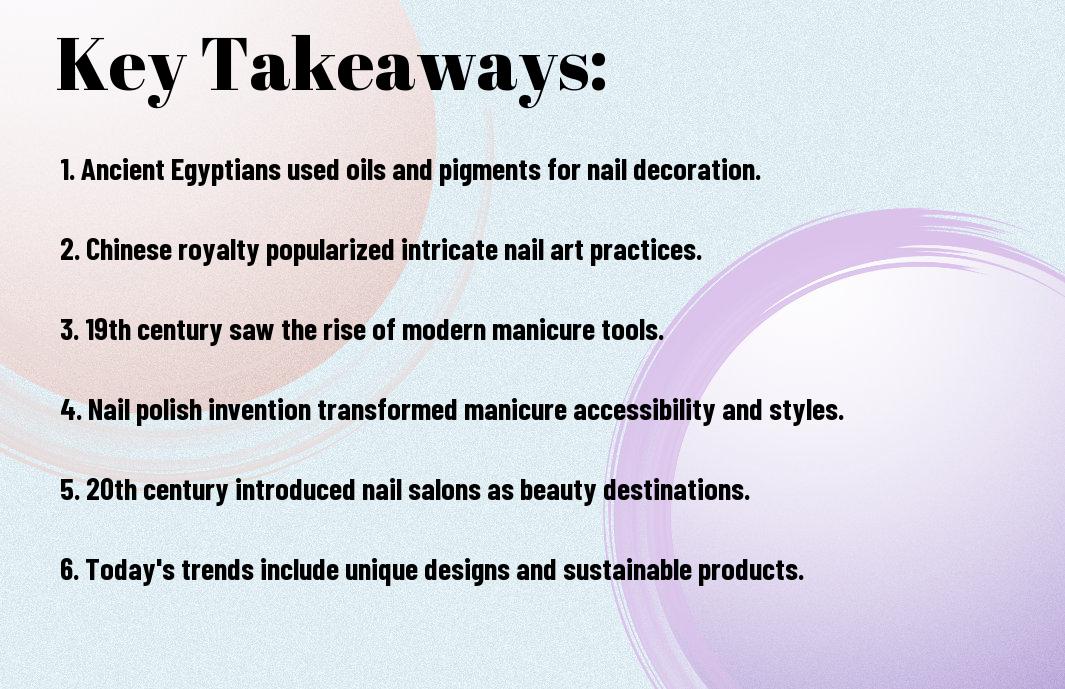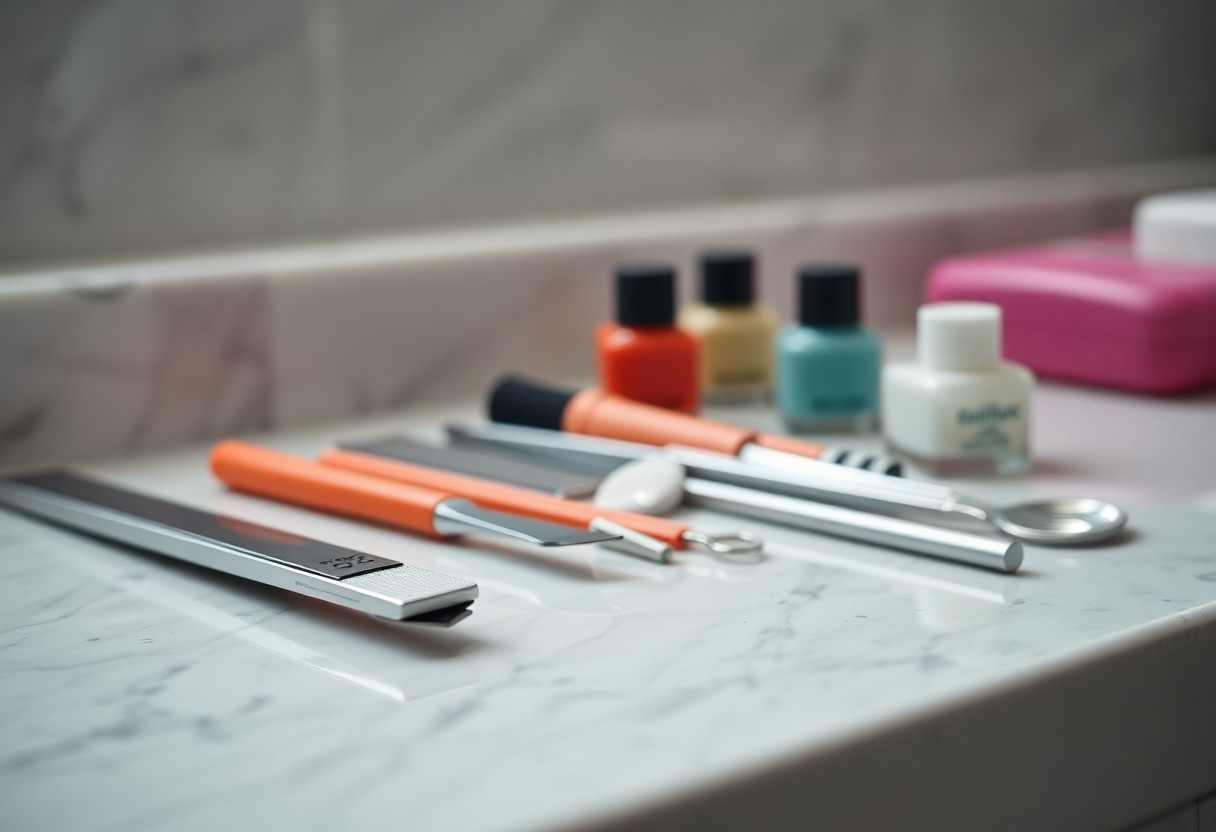History reveals that manicures are not just a modern trend; they trace back thousands of years to ancient civilizations where hand care was a sign of status and beauty. You may be surprised to learn that even in ancient Egypt, royalty adorned their nails with vibrant colors and intricate designs. As you explore the evolution of manicures, you’ll discover how cultural practices, innovations in nail care, and changing beauty standards have shaped your manicure experience today, making it a blend of art, tradition, and personal expression.

Key Takeaways:
- Ancient Origins: The practice of manicures dates back to ancient civilizations, with evidence of nail care rituals in Egypt and China, where the wealthy would adorn their nails with intricate colors and designs.
- Evolution of Techniques: Over centuries, manicure techniques and tools have evolved, transitioning from basic grooming practices to sophisticated procedures involving nail art and treatments.
- Modern Popularity: Today, manicures are a mainstream beauty practice, reflecting personal style and self-care, with a wide array of services available in salons worldwide.

The Origins of Manicures
To understand the origins of manicures, you must look back to ancient times when nail care signified wealth and status. Civilizations such as the Egyptians and Chinese crafted intricate nail designs and used various substances to enhance their appearance. For an in-depth look at the History of manicure and nail industry, you’ll find that these early practices laid the foundation for modern techniques and grooming standards.
Ancient Civilizations and Nail Care
By examining ancient civilizations, you can see that manicures were not merely about aesthetics; they carried profound significance. Egyptians used henna and adorned their nails to symbolize their social standing, while ancient Chinese practiced nail care as part of a broader beauty regimen that highlighted luxury and refinement.
The Role of Manicures in Cultural Practices
For various cultures, manicures served as a reflection of personal identity and societal norms. From ornate decorations in imperial courts to simplistic styles in everyday life, manicures became intertwined with cultural values and beauty ideals.
A deeper look into the role of manicures in cultural practices reveals that they symbolize more than just beauty. They often mark significant life events, traditions, or personal milestones. In many societies, well-groomed nails embody discipline and attention to detail, forging connections between self-care and social acceptance. You may find it interesting to explore how different cultures have embraced manicures as a form of personal expression and communal identity.
Manicures in the Middle Ages
Some historians note that during the Middle Ages, manicures were largely influenced by social status and fashion. Both men and women participated in nail grooming, often using rudimentary tools to keep their nails clean and trimmed. If you want to investigate deeper into this fascinating topic, check out The history of manicure. The beginning to the present day for a comprehensive overview.
Beauty Ideals and Nail Grooming
Around the 11th century, beauty ideas began to take shape, with the nobility setting the trends for nail grooming. Importance was placed on neat, well-maintained nails as a sign of refinement and sophistication. The upper classes often used herbal concoctions to enhance the appearance of their nails, while the lower classes managed with more practical methods to maintain cleanliness.
Health Beliefs and the Importance of Nails
Ideals of health during the Middle Ages also tied closely to nail care, as clean nails were seen as a reflection of one’s overall well-being. It was believed that well-groomed nails could help prevent sickness and promote good health. This connection between nails and health likely motivated many individuals to keep their nails neat and trimmed.
Even beyond aesthetics, nails were seen as important indicators of health. In a time when survival was directly linked to one’s physical condition, maintaining clean nails and good hygiene became a basic necessity. You may find it interesting that scrapes or infections on the nails were often viewed as omens of illness or misfortune, underscoring the significant role nails played in everyday life.
The Evolution of Modern Manicures
Your understanding of manicures would be incomplete without recognizing their evolution over the years. With the shift from basic grooming to sophisticated beauty rituals, modern manicures now encompass artistic designs and cutting-edge techniques. Curated specifically for self-expression and aesthetic appeal, manicures have transformed into an vital aspect of personal care and style in today’s world. From classic French tips to intricate nail art, the modern manicure is a versatile canvas for creativity.
The Rise of Nail Salons in the 20th Century
On the heels of the 20th century, nail salons emerged as trendy hotspots for those seeking pampering and professional care. The expansion of nail salons marked a new era where manicures became accessible and popular among not just the elite but a broader audience. This growth allowed you to indulge in personalized services, elevating nail care to an experience that blends relaxation with beauty.
Innovations in Nail Products and Techniques
Behind the scenes, the beauty industry has seen remarkable advancements in nail products and techniques. Today’s manicures benefit from high-quality, long-lasting formulas and innovative application methods that provide a superior finish. The introduction of gel and dip powders, along with tools like LED lamps, has revolutionized the way you achieve stunning nails that stand the test of time.
Another significant development in nail products and techniques is the rise of eco-friendly and non-toxic formulas, appealing to your health-conscious mindset. Brands are now offering vegan, cruelty-free options that deliver both safety and style. Moreover, techniques such as nail stamping and 3D nail art have allowed for intricate designs that were once unimaginable. You can now experiment with a plethora of styles, ensuring your nails are not just groomed, but also a unique representation of your personal flair.
Popularity of Manicures in the 21st Century
After centuries of evolution, manicures have now become a staple of personal grooming and self-expression in the 21st century. With the rise of nail salons and increased accessibility of nail care products, you can easily embrace this beauty ritual. Today’s manicures go beyond a simple polish; they encompass intricate nail art, gel options, and even 3D embellishments, catering to a vast range of styles and preferences.
Trends Influencing Modern Nail Art
The current landscape of nail art is influenced by various trends that reflect personal style and societal shifts. From abstract designs to minimalist aesthetics, you can find inspiration all around you, helping to shape your unique look. Techniques such as ombre and negative space have gained traction, enabling you to experiment and express yourself creatively through your nails.
The Influence of Social Media on Nail Culture
To understand modern nail culture, it is crucial to recognize the impact of social media platforms. With influencers and nail artists sharing their creations online, you have instant access to a wealth of ideas, techniques, and trends. These platforms have turned nail art into a communal experience, where you can not only showcase your work but also engage with a global audience.
This surge in online visibility has prompted innovative styles and DIY tutorials, making it easy for you to recreate eye-catching designs at home. Social media has also encouraged nail challenges and trends to go viral, allowing you to stay updated with what’s popular. As a result, your nails can now serve as a canvas to express your individuality, while connecting you with a vibrant, like-minded community across the globe.
Health and Safety in Nail Care
For anyone seeking nail care, understanding health and safety practices is necessary to ensure a safe and enjoyable experience. Nail salons must adhere to strict hygiene protocols to protect both clients and technicians. Focusing on sanitation, proper tool disinfection, and safe product usage can mitigate risks, allowing you to relax and enjoy your manicure while maintaining your health.
Hygiene Practices in Nail Salons
Among the key elements of a safe nail salon are stringent hygiene practices. Ensure that the technicians are using sterilized tools, fresh nail files, and clean workstations. You should look for certificates indicating the salon follows local health regulations and inquire about their sanitization methods to promote a health-conscious environment.
Common Risks and Preventative Measures
After understanding the importance of hygiene, it’s vital to be aware of potential risks associated with nail care, such as infections or allergic reactions. To minimize these risks, opt for reputable salons that prioritize cleanliness and educate their staff on safe practices.
And as you navigate your nail care journey, be observant of the products being used. Allergies can result from harsh chemicals in nail polish or removers, so consider asking for hypoallergenic alternatives. Additionally, be cautious about any cuts or abrasions; ensuring your technician uses new tools and follows safety protocols can greatly reduce your risk of infection. Your awareness and proactive approach towards health in nail care will contribute to a positive experience.
The Future of Manicures
Keep an eye on emerging trends that are shaping the future of manicures. As societal awareness of self-care and personal grooming continues to evolve, the demand for innovative and sustainable practices in nail care is increasing. Your nails are not just a canvas for creativity; they represent the intersection of self-expression and health, paving the way for new advancements in the field.
Sustainable Practices and Eco-Friendly Products
Future nail care will focus on sustainability, prioritizing eco-friendly products and practices. As consumers, you now seek out brands that minimize environmental impact, using non-toxic ingredients and biodegradable materials. This shift not only benefits your health but also contributes to a healthier planet, making your manicure a conscious choice for beauty and responsibility.
Technological Advances in Nail Care
One of the most exciting developments in the world of manicures is the inclusion of cutting-edge technology. Innovative tools are transforming traditional manicures into more efficient and precise experiences.
This includes the use of UV or LED light technology for faster curing, as well as smart devices that can analyze nail health, allowing you to customize treatments based on your unique nail needs. Virtual reality and augmented reality applications are even paving the way for virtual try-ons, giving you the chance to experiment with different colors and designs before making a decision. As these advancements continue to grow, they will enhance not only your nail care experience but also empower you to make informed choices about your manicure.
Conclusion
Taking this into account, you can appreciate how the art of manicures has evolved significantly from ancient civilizations to contemporary practices. The journey reflects cultural shifts, technological advancements, and a growing emphasis on personal grooming. By understanding this history, you can better appreciate the significance of manicures in your own life and the broader cultural context they inhabit today. Embracing these traditions allows you to connect with a rich legacy while expressing your own unique style.
FAQ
Q: What is the historical significance of manicures in ancient civilizations?
A: Manicures have been practiced for thousands of years, with evidence tracing back to ancient Egypt around 3000 BC. Egyptians used natural ingredients like henna to color their nails, which signified social status and beauty. Similarly, in ancient China, royalty would often embellish their nails with intricate designs, using materials like gold and silver to showcase their wealth and power. These early practices emphasized the importance of nail care as a reflection of one’s social standing and personal grooming.
Q: How did the manicure evolve during the Middle Ages?
A: During the Middle Ages, particularly in Europe, the focus on manicures shifted significantly. Instead of emphasizing beauty, nail care was often associated with hygiene and health. People believed that clean nails were indicative of good morality. It wasn’t until the Renaissance that manicures saw a resurgence in beauty trends, with ladies returning to elaborate nail embellishments as a display of femininity and status, aided by the use of natural dyes and adornments.
Q: When did modern manicures begin to take shape?
A: The modern manicure began to take shape in the late 19th century, particularly with the development of commercial nail polish. In 1916, the first nail polish was made available in a version similar to the automobile paint of the time, which greatly influenced nail aesthetics. The push towards professional nail care started to emerge in the 1930s with the establishment of nail salons, where skilled beauticians offered specialized manicure services, marking a shift in nail care from a personal routine to a social and salon-oriented experience.
Q: What are some key innovations in manicure products and techniques over the years?
A: The manicure industry has seen several innovations, particularly in the last few decades. The introduction of acrylic nails in the 1970s allowed for extended nail lengths and designs, while gel nail polish, which cures under UV light, became popular in the 2000s for its durability and glossy finish. Recent developments also focus on healthier alternatives, such as non-toxic polishes and eco-friendly products, catering to a growing demand for safer beauty options. Additionally, techniques like nail art and intricate designs have transformed manicures into a form of artistic expression.
Q: How have cultural differences influenced manicures around the world?
A: Cultural differences have played a significant role in the evolution of manicures worldwide. In Japan, for instance, there is a tradition of intricate nail art that often reflects seasonal themes and cultural symbols, showcasing the artistry involved in nail care. In contrast, Western societies have tended to focus on more simplistic, polished looks, while recent years have introduced a blend of these influences. Globally, nail salons have adapted their services to reflect local aesthetics and preferences, highlighting the diverse ways in which manicures are appreciated and practiced.




